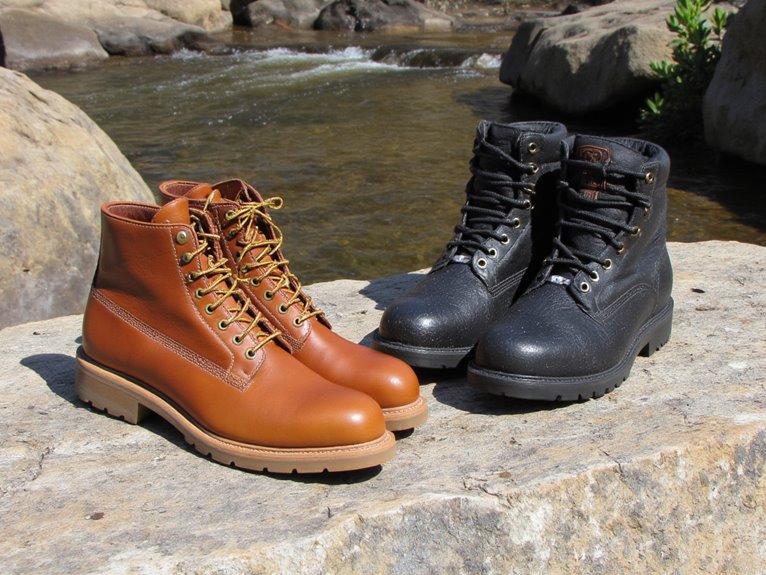10 Best Gear for Cold Weather Camping to Keep You Warm and Safe
I’ve tested dozens of cold weather camping products, and these ten items will keep you warm and safe: Alvada Merino Wool Hiking Socks provide moisture-wicking thermal regulation, while HotHands warmers deliver up to 18 hours of heat activation. The Senllen fleece balaclava adds 10°F warmth with wind protection. MEREZA double sleeping bags handle temperatures down to 28°F, and emergency Mylar blankets retain 90% body heat. These essentials create layered thermal protection systems that experienced campers rely on for survival in harsh conditions.
We are supported by our audience. When you purchase through links on our site, we may earn an affiliate commission, at no extra cost for you. Learn more. Last update on 3rd December 2025 / Images from Amazon Product Advertising API.
Notable Insights
- Merino wool hiking socks and windproof balaclavas provide essential thermal regulation and protection for extremities and face coverage.
- Heated sleeping bag liners with USB power sources offer up to 14 hours of targeted warmth for core body areas.
- Disposable hand warmers provide reliable heat activation within 15-30 minutes and deliver up to 18 hours of continuous warmth.
- Emergency Mylar thermal blankets retain up to 90% of body heat while serving multiple functions as shelter and ground protection.
- Choose sleeping bags with appropriate temperature ratings: three-season bags (20°F-50°F) or winter bags (0°F or below) for conditions.
Alvada Merino Wool Hiking Socks for Men & Women (3 Pairs)

When temperatures drop below freezing and moisture becomes your enemy, the Alvada Merino Wool Hiking Socks deliver the thermal regulation and sweat management that cold-weather campers need. These unisex socks feature strategic cushioning at the arch, heel, and toe areas for extended comfort during winter treks.
The merino wool construction provides natural moisture-wicking properties while maintaining breathability. You won’t experience overheating inside winter boots. The solid stitching construction resists pilling and shape loss through multiple wash cycles.
The 3-pack design offers rotation flexibility for multi-day camping trips. Users report significant odor reduction and moisture control in freezing conditions. The socks accommodate both regular and wide feet without slipping or bunching.
Best For: Cold-weather outdoor enthusiasts, winter hikers, and anyone working in freezing environments who need warm, moisture-wicking socks that prevent odor and provide cushioned comfort.
Pros:
- Excellent thermal regulation with merino wool’s natural moisture-wicking and breathability properties
- Strategic cushioning at arch, heel, and toe areas provides superior comfort during extended wear
- Durable construction with solid stitching that maintains shape and resists pilling through multiple washes
Cons:
- Limited color options, especially when seeking discounted pricing
- May be overkill for mild weather conditions due to their thermal properties
- Higher price point compared to basic synthetic hiking socks
HotHands Toe, Hand, & Body Warmer Variety Pack
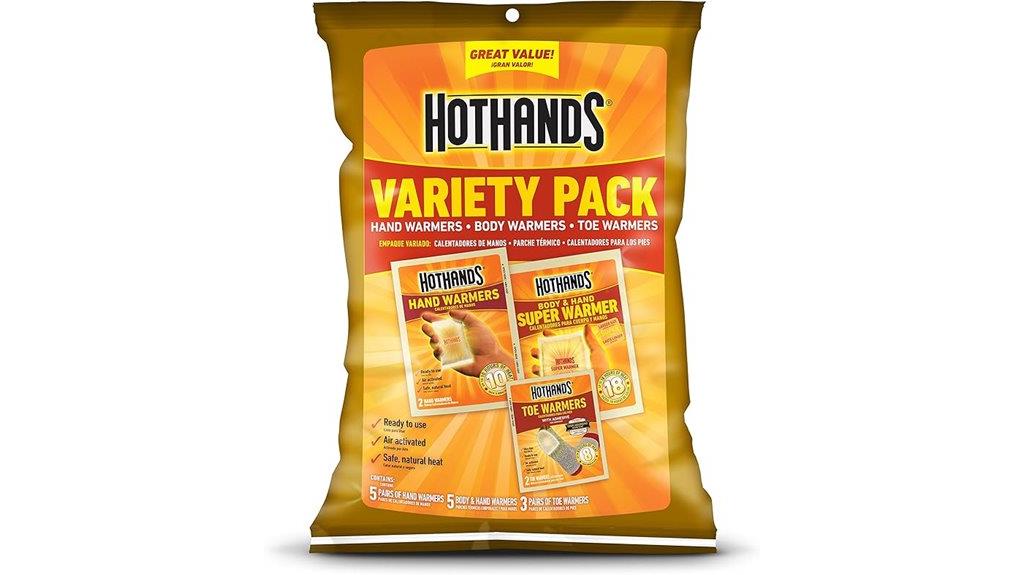
HotHands Toe, Hand, & Body Warmer Variety Pack delivers up to 214 hours of heat across multiple disposable warmers, making it an essential backup heating system for campers who face extended cold exposure. These air-activated warmers heat up in 15-30 minutes after you remove them from their packaging and shake them. You’ll get consistent warmth for your hands, feet, and body without odor or bulk.
The TSA-approved design makes these warmers travel-friendly for camping trips. If heat output decreases, simply expose the warmer to air and shake it again to reactivate the heating process. Don’t apply them directly to your skin—use them inside gloves, boots, or clothing layers instead.
Best For: Outdoor enthusiasts, campers, hunters, and anyone who needs portable, long-lasting warmth during cold weather activities or extended time outdoors.
Pros:
- Provides up to 214 hours of total heat across the variety pack, offering excellent value and extended warmth
- Air-activated and ready to use in 15-30 minutes with no batteries or external power source required
- TSA-approved and portable design makes them convenient for travel and outdoor activities
Cons:
- Single-use disposable items that create waste and require repurchasing for continued use
- Cannot be applied directly to skin, limiting placement options and requiring clothing layers
- Heat output can decrease over time and may require reactivation by shaking and air exposure
HotHands Body & Hand Super Warmers (10 Individual Warmers)
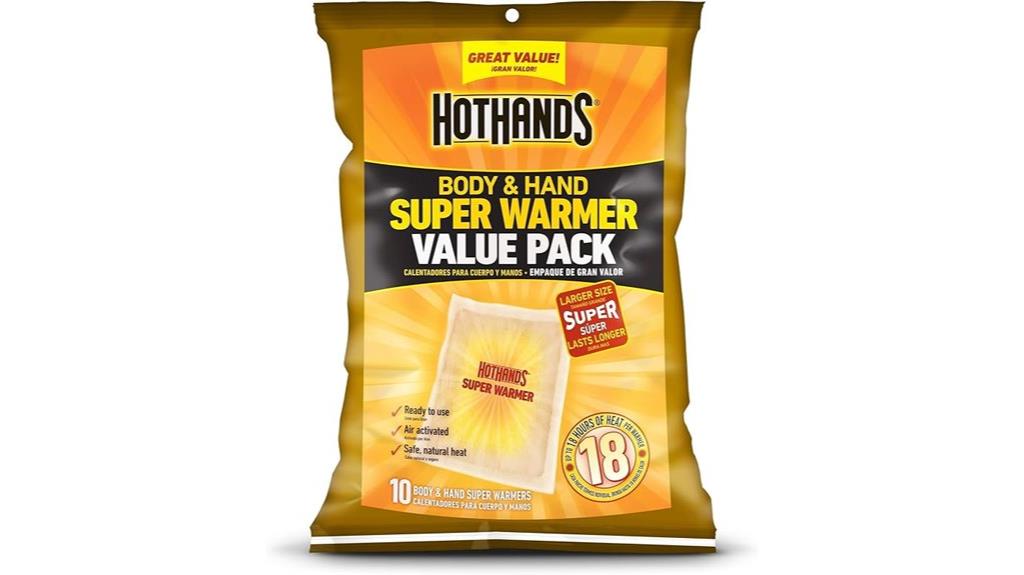
Cold weather warriors need reliable heat sources that won’t quit when temperatures plummet, and HotHands Body & Hand Super Warmers deliver consistent warmth for up to 18 hours per unit. This 10-pack provides extended heating capacity for multi-day camping trips.
Activation requires simple shaking after removing from packaging. Heat builds within 15-30 minutes through air-activated technology. You don’t need additional kneading or manipulation. If warmth diminishes, expose the warmer to air and shake again to restore heat output.
These compact units work effectively for camping activities including hiking, fishing, and outdoor cooking. They’re TSA-approved for travel and completely odorless during operation. Each warmer functions as single-use only, requiring standard garbage disposal afterward.
Best For: Outdoor enthusiasts, campers, hunters, and anyone who spends extended time in cold weather conditions and needs reliable, long-lasting portable heat sources.
Pros:
- Provides up to 18 hours of consistent heat per warmer, offering exceptional longevity for extended outdoor activities
- Simple air-activation with just shaking required – no complicated setup or additional equipment needed
- TSA-approved and odorless design makes them convenient for travel and won’t disturb others in close quarters
Cons:
- Single-use disposable design creates ongoing waste and replacement costs for regular users
- 15-30 minute activation time means you can’t get immediate heat when needed urgently
- Cannot be applied directly to skin, limiting placement options and requiring clothing or gear as a barrier
REDCAMP Large Camping Blanket with Sherpa Lining, Windproof & Machine Washable
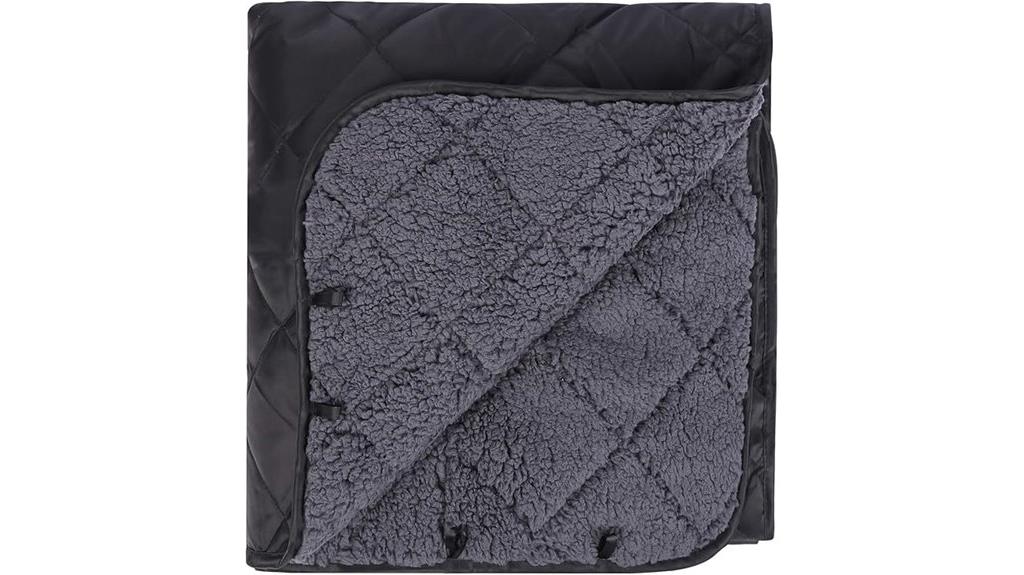
Stadium-goers and car campers who need versatile warmth protection will find the REDCAMP Large Camping Blanket delivers exceptional comfort through its three-layer construction. You’ll get 78.8×59″ coverage from 150D oxford backing, 250gsm polyester sherpa lining, and 60gsm polyester wadding filling. The windproof design keeps you warm at outdoor events while remaining packable at φ8.5×13.8″ and 2.6lbs. You can machine wash this multipurpose blanket that works for camping, picnics, sports events, or as pet protection. The water-resistant backing protects against moisture, though the sherpa lining isn’t waterproof. REDCAMP backs this blanket with a 365-day warranty.
Best For: Stadium-goers, car campers, and outdoor enthusiasts who need a versatile, windproof blanket that packs down compactly for camping, picnics, sports events, and pet protection.
Pros:
- Three-layer construction with sherpa lining provides excellent warmth and comfort while maintaining windproof protection
- Compact and lightweight design packs down to φ8.5×13.8″ at only 2.6lbs, making it highly portable for travel
- Machine washable with water-resistant backing and versatile multipurpose use from camping to pet protection
Cons:
- Sherpa lining is not waterproof, limiting protection in wet conditions despite water-resistant backing
- At 2.6lbs, it’s heavier than ultralight camping alternatives for backpacking applications
- Large 78.8×59″ size may be cumbersome for solo use or tight spaces despite being packable
HotHands Lap Warmer, 16 X 10 – Up to 8 Hours Heat
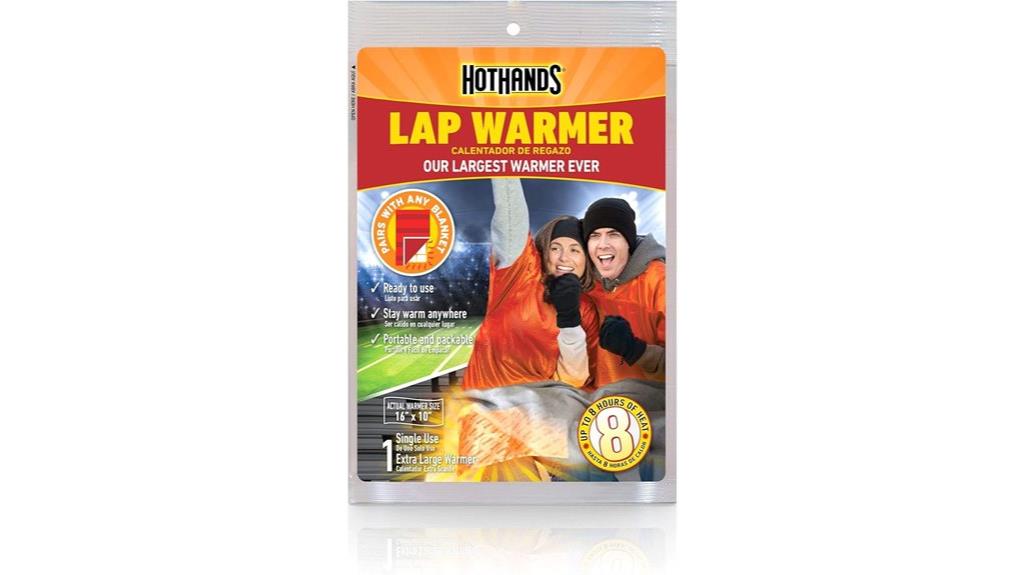
When you need reliable warmth that covers more surface area than standard hand warmers, the HotHands Lap Warmer delivers consistent heat across its generous 16 x 10-inch coverage zone. This single-use warmer reaches 163°F and maintains heat for up to eight hours. You’ll activate it by removing the outer package and shaking—heat develops within 15-30 minutes. The iron-based formula weighs 13.1 ounces and operates odorlessly. It’s TSA-approved for travel and works effectively for camping, hunting, and outdoor sports. If heat decreases, expose it to air and shake again. You can dispose of used warmers in regular garbage.
Best For: People who need extended warmth coverage for outdoor activities like camping, hunting, tailgating, or sports events where standard hand warmers don’t provide enough surface area.
Pros:
- Large 16 x 10-inch coverage area provides significantly more warmth than standard hand warmers
- Long-lasting heat for up to 8 hours at 163°F temperature
- TSA-approved for travel and activates quickly within 15-30 minutes
Cons:
- Single-use disposable design makes it less economical for frequent use
- At 13.1 ounces, it’s heavier and bulkier than standard hand warmers
- Requires disposal in regular garbage, creating more waste than reusable alternatives
Heated Sleeping Bag Pad with 5 Heating Zones (USB Powered)
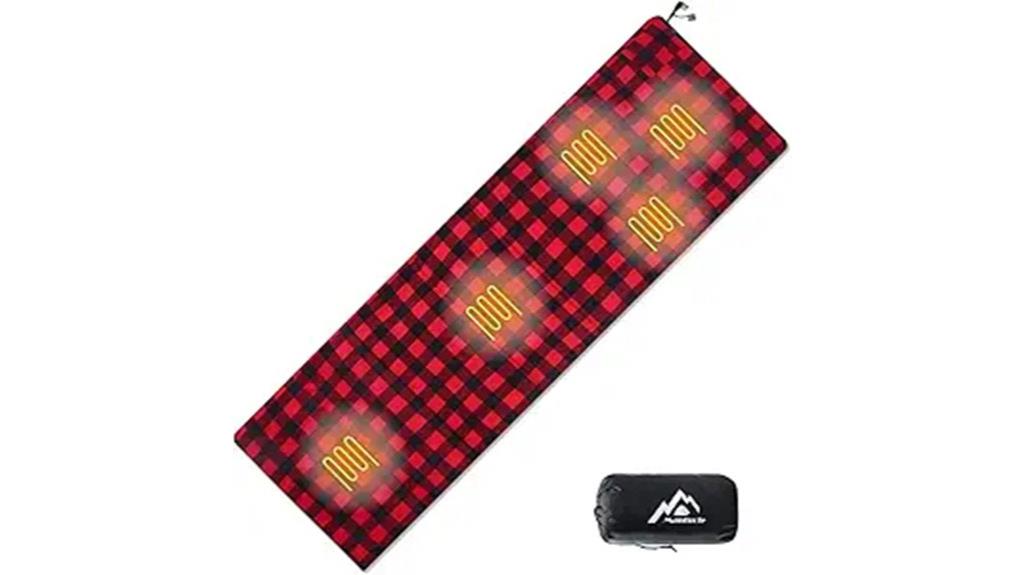
The MANTUOLE Heated Sleeping Bag Liner transforms your overnight camping experience with five strategically placed heating zones that target your shoulders, back, hips, and feet – the areas where you’ll lose the most body heat during frigid nights. This 6.5 x 3-foot pad operates on any 5V/2A USB power source, delivering 6-14 hours of continuous warmth when paired with a 20,000 mAh power bank.
The waterproof polyester shell withstands harsh conditions while the flannel lining provides comfort. You’ll control three temperature settings with simple button presses – red for high heat, blue for medium, and green for low. At just 2 pounds, it packs into compact dimensions for easy transport and serves multiple purposes beyond sleeping arrangements.
Best For: Cold-weather campers, van lifers, and outdoor enthusiasts who need supplemental warmth for sleeping but already have a power bank and don’t mind carrying extra gear.
Pros:
- Five strategically placed heating zones target key body areas where heat loss occurs most
- Long battery life of 6-14 hours with three adjustable temperature settings for customized warmth
- Versatile design works as sleeping pad, blanket, or seat cushion with waterproof shell and comfortable flannel lining
Cons:
- Requires separate purchase of 20,000 mAh power bank, adding cost and weight to your gear
- Some users report inadequate heating levels and inconvenient connector placement
- Not effective as a standalone heat source, requiring additional warming methods for very cold conditions
Emergency Mylar Thermal Blankets (4-Pack) for Outdoors & Survival
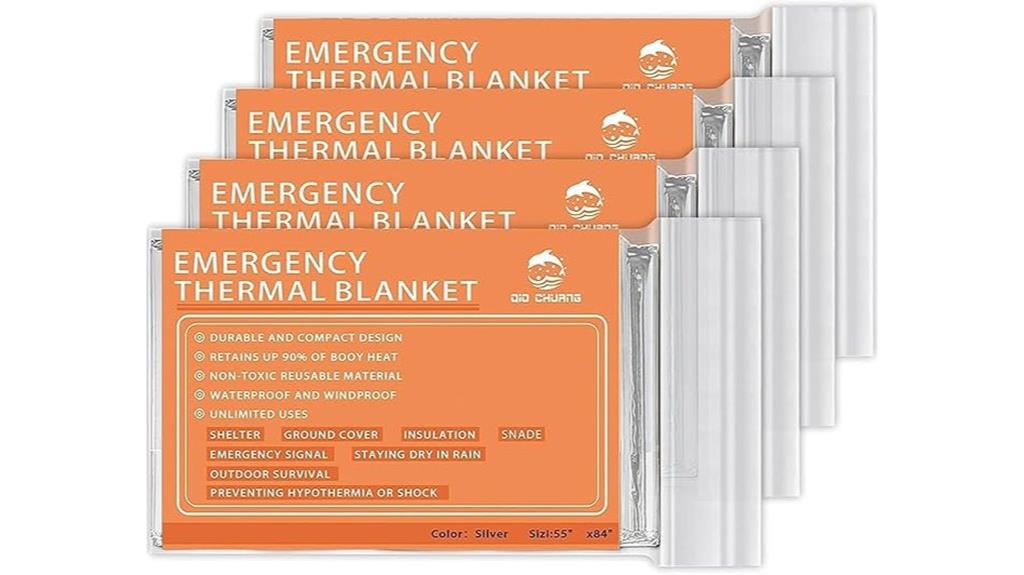
Emergency preparedness enthusiasts and outdoor adventurers need reliable thermal protection when temperatures drop unexpectedly. The QIO CHUANG Emergency Mylar Thermal Blankets deliver essential warmth retention in a compact 4-pack solution. These 84-inch by 55-inch blankets trap up to 90% of your body heat through heavyweight polyester construction with reflective Mylar fabric.
You’ll appreciate their versatility beyond emergency warming. They function as tent footprints, rain ponchos, ground covers, and emergency shelters. The waterproof, windproof design withstands harsh conditions while remaining lightweight at just 8.3 ounces total. Bright orange coloring enhances rescue visibility.
Each blanket requires careful handling despite tear-resistant materials. Machine washing capability guarantees reusability for multiple adventures.
Best For: Emergency preparedness enthusiasts, outdoor adventurers, hikers, campers, marathon runners, and anyone who needs reliable thermal protection and versatile emergency gear for unexpected weather conditions.
Pros:
- Retains up to 90% of body heat with reflective Mylar fabric while remaining ultra-lightweight at just 8.3 ounces for all four blankets
- Highly versatile with multiple uses including emergency shelter, tent footprint, rain poncho, and ground cover beyond basic thermal protection
- Excellent value with top ratings (4.7/5 stars from nearly 7,000 reviews) and includes four blankets for comprehensive emergency preparedness
Cons:
- Requires careful handling despite tear-resistant claims, as the material can be damaged with rough use
- Individual packaging may be difficult to open quickly during actual emergency situations when dexterity is compromised
- Can be noisy when moving or adjusting the blanket, which may be disruptive in quiet environments or sleeping situations
Senllen Balaclava Cold Weather Fleece Windproof Ski Mask
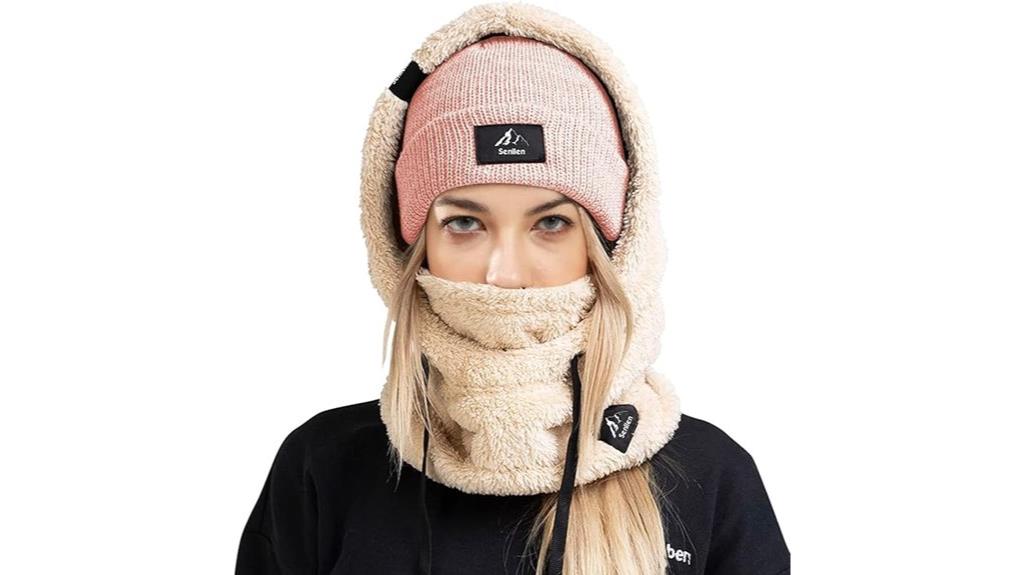
Cold weather campers who prioritize breathability without sacrificing warmth will find exceptional value in the Senllen Balaclava Cold Weather Fleece Windproof Ski Mask. This versatile face protection adds up to 10°F of warmth to your existing gear. The fleece construction maintains breathability while blocking wind effectively.
You’ll appreciate the adjustable drawstring system that customizes fit around your head and face. The design functions as both full-face coverage and neck gaiter when you pull the hood down. Performance excels in dry, snowy conditions but decreases noticeably when wet, as the fleece retains moisture rather than wicking it away.
The lightweight construction won’t weigh down your pack, making it ideal for extended winter camping expeditions where every ounce matters.
Best For: Cold weather campers and winter sports enthusiasts who need lightweight, breathable face protection in dry, snowy conditions and want versatile gear that can function as both full coverage and neck gaiter.
Pros:
- Adds up to 10°F of warmth while maintaining breathability and lightweight construction for extended wear
- Adjustable drawstring system and versatile design allows use as full-face coverage or neck gaiter
- Excellent performance in dry, snowy conditions with effective wind blocking capabilities
Cons:
- Significantly decreased effectiveness in wet conditions as fleece retains moisture rather than wicking it away
- Nose and mouth cover may slip during use, requiring readjustment
- Product appearance may differ from advertised photos
MEREZA Double Sleeping Bag for Adults with Pillow (XL Queen Size Two Person)
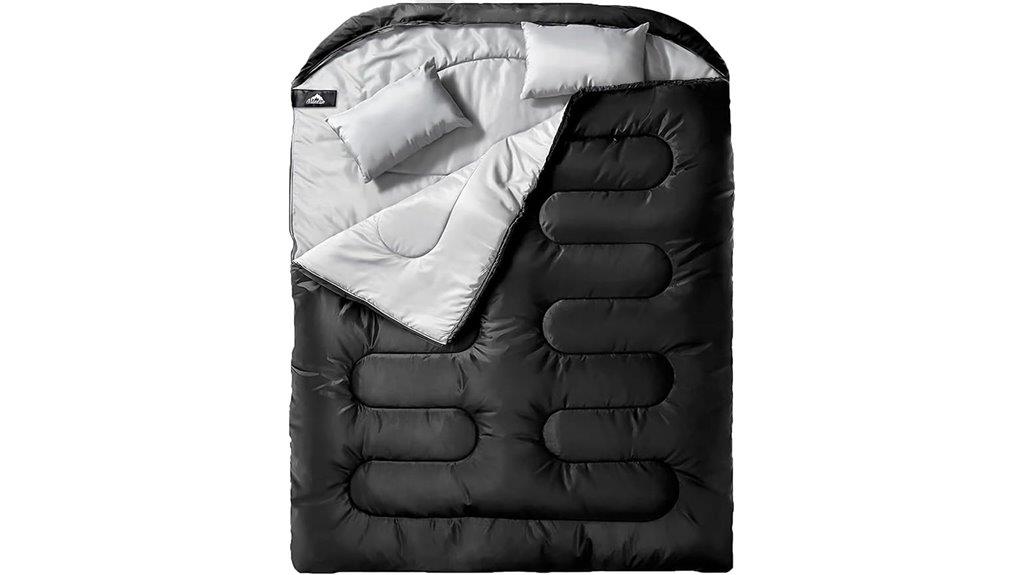
Couples seeking warmth and comfort during cold-weather camping adventures will find the MEREZA Double Sleeping Bag delivers exceptional value through its XL Queen size design. This rectangular bag measures 90.6L x 61W inches and accommodates two people up to seven feet tall. The 220-gram polyester fill provides thermal protection in temperatures from 28 to 59 degrees Fahrenheit. You’ll appreciate the separated bottom zipper that enables foot ventilation for temperature regulation. The bag converts into two individual sleeping bags when needed. At 7.7 pounds, it compresses efficiently into the included storage sack. Two camping pillows complete this thorough sleep system.
Best For: Couples who want a spacious, comfortable sleeping solution for moderate temperature camping (28-59°F) and prefer the flexibility of converting between a double bag and two separate bags.
Pros:
- XL Queen size design (90.6L x 61W inches) accommodates two people up to 7 feet tall with room for comfortable movement
- Versatile convertible design splits into two individual sleeping bags or can be used as queen-sized blankets
- Includes practical features like separated bottom zipper for foot ventilation, compression storage sack, and two camping pillows
Cons:
- Limited cold weather performance may require additional blankets in extreme conditions below the 28°F rating
- Included camping pillows are reportedly inadequate according to user feedback
- Washing the sleeping bag may cause damage based on customer concerns
MalloMe Sleeping Bags for Adults Cold Weather & Warm
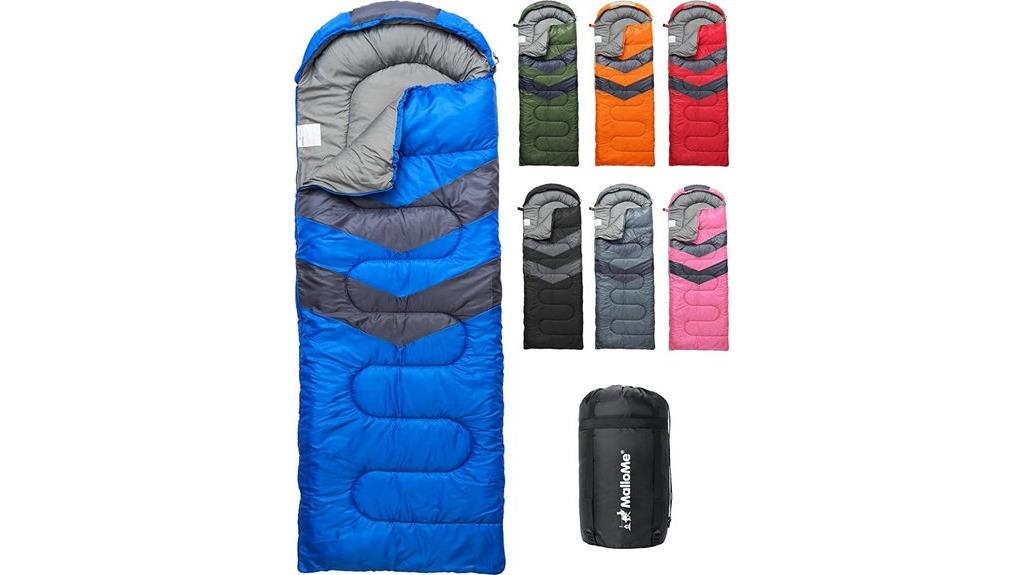
Year-round versatility defines the MalloMe Sleeping Bags for Adults Cold Weather & Warm, making them an excellent choice for campers who need reliable gear across multiple seasons. You’ll find these bags rated for temperatures between 50°F to 77°F, perfect for three-season camping adventures.
The rectangular design measures 86.6L x 31.5W inches and weighs approximately 3 pounds. You’ll appreciate the ultra-strong, waterproof hex-tech outer shell paired with 3D synthetic fiber insulation for consistent warmth retention. Double-sided, snag-free zippers and velcro straps guarantee secure closure.
At under $50, you’re getting exceptional value that’s earned 4.5 stars from over 14,000 customers. The compression sack makes storage effortless for backpacking trips.
Best For: Three-season campers, hikers, and backpackers who need a versatile, budget-friendly sleeping bag that performs well in moderate temperatures from 50°F to 77°F.
Pros:
- Excellent value under $50 with 4.5-star rating from over 14,000 customers and waterproof hex-tech outer shell
- Lightweight at 3 pounds with compression sack for easy storage and transport during backpacking trips
- Year-round versatility with temperature rating suitable for spring, summer, and fall camping adventures
Cons:
- Some customer complaints about zipper durability issues with extended use
- Storage bag quality reported as subpar by some users
- Factory packaging smell requires washing before first use
Factors to Consider When Choosing Gear for Cold Weather Camping
I’ll guide you through five critical factors that determine whether your cold weather gear keeps you safe and comfortable in harsh conditions. Temperature ratings serve as your first line of defense, but you must understand that manufacturers often use different testing standards, making it essential to choose gear rated at least 10-15 degrees below your expected lowest temperature. The interplay between material selection, insulation type, weight considerations, weather protection, and durability creates a complex decision matrix that directly impacts your survival and comfort in extreme environments.
Temperature Ratings Matter
Temperature ratings serve as your primary guide when selecting cold weather camping gear, but these numbers tell only part of the story. I recommend understanding the distinction between “comfort” and “limit” ratings. Comfort ratings indicate ideal temperatures for average users, while limit ratings mark survival thresholds.
Three-season bags typically range from 20°F to 50°F. Winter bags drop to 0°F or below. However, I’ve learned that personal factors heavily impact these ratings. Your metabolism, humidity levels, wind exposure, and sleeping pad R-value all affect warmth retention.
Lower-rated bags incorporate denser insulation and superior draft collars to minimize heat loss. I always factor in additional layers—base clothing and insulated pads—rather than relying solely on bag ratings for extensive cold weather protection.
Material and Insulation
When selecting insulation for cold weather camping gear, the choice between down and synthetic fill determines your equipment’s performance, weight, and reliability in harsh conditions. Down insulation offers superior warmth-to-weight ratios but loses effectiveness when wet. Synthetic fills maintain insulation properties in moisture but weigh more than down.
Fill power ratings indicate down’s loft capacity and thermal efficiency. Higher numbers mean better compressibility and warmth. I recommend 700-fill power minimum for cold weather applications.
Water-resistant treatments protect insulation integrity. Look for DWR coatings on outer fabrics and hydrophobic down treatments that resist moisture absorption.
Breathable materials prevent moisture buildup from sweat. Base layers should feature moisture-wicking fabrics like merino wool or technical synthetics. This prevents dampness that increases heat loss and compromises your thermal regulation system.
Weight Vs Warmth
Beyond material selection, the weight-to-warmth ratio becomes your primary consideration when building a cold weather gear system. Down insulation delivers superior warmth-per-ounce compared to synthetic alternatives, typically providing 20-30% better thermal efficiency. However, down requires careful moisture management and costs more initially.
I recommend evaluating temperature ratings against actual pack weight. A sleeping bag rated for 0°F might weigh 3-4 pounds, while a 20°F bag weighs 2-3 pounds. The difference impacts your hiking endurance over long distances.
Consider layering systems instead of single heavy items. Three lightweight merino wool layers totaling 12 ounces often outperform one 16-ounce jacket while offering temperature adaptability.
Compact gear design matters equally. Modern synthetic fills achieve 85% of down’s warmth-to-weight ratio while maintaining performance when wet.
Waterproof and Windproof
Two essential barriers stand between you and hypothermia in cold weather camping: waterproof and windproof protection. These features prevent moisture penetration from snow and rain while blocking heat-robbing winds that destabilize your core temperature.
I prioritize gear with DWR (Durable Water Repellent) coatings on waterproof fabrics. These treatments enhance performance against wet conditions on jackets and sleeping bags. For windproof functionality, I look for tighter fabric weaves and adjustable closures that minimize cold air infiltration.
The combination creates a vital microclimate within your sleeping system and shelter. This microclimate greatly improves thermal insulation during expeditions. Without these protective barriers, even the warmest gear becomes ineffective when moisture compromises insulation or wind strips away precious body heat.
Durability in Elements
Four critical durability factors determine whether your cold weather gear survives brutal conditions or fails when you need it most. I prioritize waterproof fabrics with breathability ratings above 10,000g/m²/24hr to handle moisture without compromising ventilation. Reinforced seams with taped construction prevent water infiltration at stress points where regular stitching fails.
Tear-resistant properties matter most in high-wear items. I look for ripstop nylon with minimum 40-denier thread count in sleeping bags and jackets. This fabric structure stops small tears from spreading into major failures.
Durability ratings reveal real-world performance. Gear tested to -20°F undergoes freeze-thaw cycles that simulate actual conditions. Easy maintenance extends lifespan considerably. Choose materials that shed dirt naturally or clean with standard detergents without losing water-repellent treatments.
Packability and Storage
Durable gear means nothing if you can’t carry it efficiently to your campsite. I prioritize items with compression sacks that reduce pack volume by 40-60%. Lightweight gear is essential—your sleeping bag shouldn’t exceed 3-4 pounds while maintaining temperature ratings to 0°F. Check storage dimensions against your backpack’s capacity. A 65-liter pack typically accommodates compressed cold-weather essentials for weekend trips.
Versatile items reduce gear count considerably. A synthetic insulated jacket doubles as pillow stuffing. Multi-fuel stoves handle various canister types. I choose waterproof materials that clean easily with simple wipe-downs. Gore-Tex and ripstop nylon shed moisture while maintaining packability.
Match gear dimensions to tent vestibule space—most two-person winter tents offer 8-12 square feet. Compressed gear expands 2-3 times when unpacked, so plan accordingly.
Frequently Asked Questions
What Temperature Rating Should I Look for in a Cold Weather Tent?
I’d recommend looking for a tent rated for temperatures at least 10-15 degrees below what you’ll actually encounter. This safety margin guarantees you’ll stay protected even if conditions worsen unexpectedly during your trip.
How Do I Prevent My Water Bottles From Freezing Overnight While Camping?
I keep my water bottles inside my sleeping bag or wrap them in insulation. I’ll also use insulated bottle covers and sometimes add a bit of salt to lower the freezing point slightly.
What Type of Base Layers Work Best for Cold Weather Camping Activities?
I recommend merino wool base layers for their superior moisture-wicking and odor-resistance properties. They’ll keep you dry and warm during active camping. Synthetic options work well too, but avoid cotton since it retains moisture and loses insulation.
How Often Should I Replace the Batteries in Heated Camping Gear?
I replace heated gear batteries before every camping trip and carry spares. Cold temperatures drain batteries faster, so I check power levels daily during extended trips and swap them out when they drop below fifty percent.
What Foods Provide the Most Energy and Warmth During Cold Weather Camping?
I’d recommend high-calorie foods like nuts, dried fruits, and energy bars that your body can quickly convert to heat. Hot soups and warm drinks also help maintain your core temperature effectively.
On a final note
Cold weather camping demands proper gear selection to prevent hypothermia and guarantee survival. I’ve outlined essential items that’ll keep you warm when temperatures drop below freezing. Your sleeping system forms the foundation—choose bags rated 10-15 degrees below expected lows. Layer merino wool against skin for moisture management. Pack multiple heat sources including chemical warmers and insulated blankets. Don’t compromise on quality—your life depends on reliable gear performance in harsh conditions.


